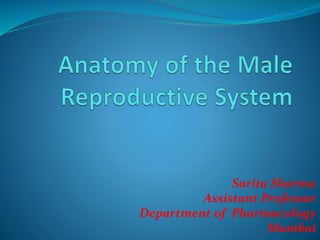
Anatomy & Physiology of the Male Reproductive System
- 1. Sarita Sharma Assistant Professor Department of Pharmacology Mumbai
- 4. Anatomy of the Male Reproductive System External genitalia (can be seen on the body surface) penis Scrotum Internal genitalia (can’t be seen on the body surface) sperm producing organs testes ducts that move sperm from the testes out of the body epididymis vas (ductus) deferens Urethra exocrine glands (ACCESSORY SEX GLANDS) that secrete fluids into the ducts adding to the sperm to make semen seminal vesicles prostate gland bulbourethral (Cowper’s) gland
- 5. MALEREPRODUCTIVEORGANS External Genital Organs 1. Penis 2. Scrotum InternalGenital Organs 1. Testis 2. Epididymis 3. VasDeferens 4. Accessory Glands a. Seminal Vesicles b. Prostate Gland c. Bulbourethral Glands
- 6. 1. Penis External penis consists of: a shaft a glans penis- a prepuce (foreskin) covers the glans Internal penis consists of: the urethra :transports urine and semen out of the body . three cylindrical bodies of erectile tissue, a spongy network of vascular spaces which fill with blood during sexual excitement. Corpora cavernosa : paired erectile bodies dorsal to the urethra which are responsible for erection . Corpus spongiosum :surrounds the urethra and prevents the collapse of the urethra during erection.
- 7. Penis
- 8. 2. Scrotum Sac of skin and muscle that hangs outside the abdominal cavity which hold the testes Its external positioning keeps the testes at 34C which is required for sperm production Two sets of muscles maintain testicular temperature: dartos a layer of smooth muscle deep to the skin cremaster smooth muscle surrounding the testes Contraction/relaxation of both muscles raise/lower the testes toward/away from the abdominal cavity increasing/decreasing testicular temperature
- 10. 1. Testis 2. Epididymis 3. VasDeferens 4. Accessory Glands a. Seminal Vesicles b. Prostate Gland c. BulbourethralGlands
- 11. 1.Testes Organs responsible for the production of: male sex steroid hormone testosterone Sperm Organized into hundreds of sperm producing seminiferous tubules the tubules are made of a simple columnar epithelium of sertoli (Nurse) cells the sperm development (spermatogenesis) occurs between sertoli cells from the basal surface (inside the body) of the seminiferous tubule to the lumen (outside the body) Interstitial (Leydig) cells found between adjacent seminiferous tubules synthesize testosterone Fluid within the seminiferous tubules flows toward the epididymis carrying the sperm
- 12. Testes
- 14. 2. Epididymis A mass of coiled tubes on the superficial surface of each testis that the sperm must pass through prior to ejaculation Sperm become mature (capable of fertilizing an ovum) as pass through its tubes toward the vas deferens During ejaculation, a layer of smooth muscle that surrounds the distal epididymis contracts, expelling sperm into the vas deferens
- 15. Epididymis Consists of tightly coiled ductus epididymis Stereocilia are microvilli that reabsorb degenerated sperm Site of sperm maturation – acquire motility and ability to fertilize Can store sperm for several months Continues as ductus (vas) deferens
- 16. The vas deferens is a thin tube that starts from the epididymis to the urethra in the penis. Conveys sperm during sexual arousal through peristaltic contractions Can also store sperm several months 3.VasDeferens(DuctusDeferens)
- 17. a. SeminalVesicles b. ProstateGland c. Bulbourethral Glands Theseglands produce nourishing fluids for the sperms that enter the urethra. 4. Accessoryglands(secrete most of liquid portion of semen)
- 18. a.SeminalVesicles TheSeminal Vesiclesare sac-like structures attached to the vasdeferens at one side of the bladder. Theyproduce asticky yellowish fluid that contains fructose.
- 20. b. ProstateGland TheProstate Gland surrounds the ejaculatory ducts at the baseof the urethra, just below the bladder. TheProstate Gland is responsible for making the production of semen, aliquid mixture of sperm cells, prostate fluid and seminal fluid.
- 21. c. Bulbourethral Glands((Cowper’s Glands)) TheBulbourethral Glands are two small glands located on the sidesofthe urethra just below the prostate gland. Theseglandsproducea clear,slippery fluid that empties directly intothe urethra. 2 pea-sized glands inferior to the prostate Produce thick, clear mucus during erection which: neutralizes traces of acidic urine in the urethra lubricates the urethra to facilitate the ejaculation of semen
